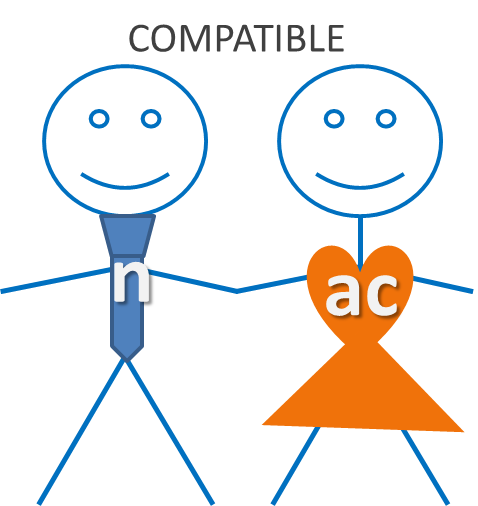
In previous iterations of WiFi standards mixing technologies (802.11a/b/g/n) was like mixing oil and water. It was a no-go, it had the potential for a disaster and made migrations from one technology to the next complicated. In order to achieve a green field replacement of your current WLAN technology you had to remove all the current access points and then put up the new ones. This created many headaches for network admins and the staff they were trying to support.
The Next Generation
However, today we have the next generation 802.11ac WLAN products being introduced into the marketplace and some early deployments going on. Unlike previous experiences with legacy technologies these migrations and deployments are going smoothly because 802.11ac can be mixed with 802.11n without negative impacts.
The reason for this successful mingling of different technologies is that they are more similar than they are dissimilar. 802.11ac takes many of the features from 802.11n and builds upon them:
- MIMO – 802.11ac utilizes the multiple spatial streams introduced in 802.11n to continue to give us those multiple paths for faster sending (TX) and receiving (RX) of data.
- Channel Bonding – 802.11ac adds to
 the channel bonding by increasing channel widths. With legacy 802.11a/b/g we used 20Mhz wide channels. 802.11n allowed bonding of multiple 20Mhz wide channels to give us 40Mhz wide channels. 802.11ac ups the game and during this first generation of the technology we can realize 80Mhz wide channels. In future versions of 802.11ac 160Mhz wide channels will be realized. More lanes of throughput = more bandwidth.
the channel bonding by increasing channel widths. With legacy 802.11a/b/g we used 20Mhz wide channels. 802.11n allowed bonding of multiple 20Mhz wide channels to give us 40Mhz wide channels. 802.11ac ups the game and during this first generation of the technology we can realize 80Mhz wide channels. In future versions of 802.11ac 160Mhz wide channels will be realized. More lanes of throughput = more bandwidth. - Modulation – 802.11n modulated at 64QAM and 802.11ac will modulate up to 256QAM. Without doing a deep dive on modulation suffice it to say that both technologies share a common modulation scheme at 64QAM and will play nice together.
Because of the potential for combining the two technologies on the same WLAN we have been able to provide some high performance designs for our customers that also save some dollars.

Right now the only 802.11ac access points that are on the market are the “flagship” models. These are the manufacturers “pride and joy” and they are on the expensive side since they are brand new.
Eventually the prices will come down like they always have as technologies mature. In the meantime until those prices are reduced we have analyzed our customers’ requirements and needs and designed 802.11n in spaces where it makes sense; isolated RF domains, low number of wireless users, coverage only areas, etc…
Greater Support
We have then designed 802.11ac into areas where it is sensible to put them; auditoriums, media centers, libraries, computer labs, conference rooms, meeting areas, and closely situated classrooms. 802.11ac has the capacity to support large numbers of wireless devices and provides greater data rates than 802.11n at the same distances, even with 802.11n devices!
This means we can support, in certain instances, several classrooms of devices from one access point where we might have had to use 2 or 3 802.11n access points previously.
If you are testing the waters of an 802.11ac implementation and have questions or would like to see how it can help your wireless network contact us here. We hope we can be a resource to you in helping plan your next generation of wireless networking.




